1. Swerdlow SH, Campo E, editors. WHO classification of tumours of haematopoietic and lymphoid tissues. 2008. 4th ed. Lyon: IARC Press;p. 110.
2. Michels SD, McKenna RW, Arthur DC, Brunning RD. Therapy-related acute myeloid leukemia and myelodysplastic syndrome: a clinical and morphologic study of 65 cases. Blood. 1985; 65:1364–1372. PMID:
3857944.

3. Le Beau MM, Albain KS, Larson RA, Vardiman JW, Davis EM, Blough RR, et al. Clinical and cytogenetic correlations in 63 patients with therapy-related myelodysplastic syndromes and acute nonlymphocytic leukemia: further evidence for characteristic abnormalities of chromosomes no. 5 and 7. J Clin Oncol. 1986; 4:325–345. PMID:
3950675.

4. Smith SM, Le Beau MM, Huo D, Karrison T, Sobecks RM, Anastasi J, et al. Clinical-cytogenetic associations in 306 patients with therapy-related myelodysplasia and myeloid leukemia: the University of Chicago series. Blood. 2003; 102:43–52. PMID:
12623843.

5. Rowley JD. International workshop on the relationship of prior therapy to balanced chromosome aberrations in therapy-related myelodysplastic syndromes and acute leukemia: overview report. Genes Chromosomes Cancer. 2002; 33:331–345. PMID:
11921269.

6. Rund D, Krichevsky S, Bar-Cohen S, Goldschmidt N, Kedmi M, Malik E, et al. Therapy-related leukemia: clinical characteristics and analysis of new molecular risk factors in 96 adult patients. Leukemia. 2005; 19:1919–1928. PMID:
16167058.

7. Pedersen-Bjergaard J. Insights into leukemogenesis from therapy-related leukemia. N Engl J Med. 2005; 352:1591–1594. PMID:
15829541.

8. Pedersen-Bjergaard J, Specht L, Larsen SO, Ersbøll J, Struck J, Hansen MM, et al. Risk of therapy-related leukaemia and preleukaemia after Hodgkin's disease. Relation to age, cumulative dose of alkylating agents, and time from chemotherapy. Lancet. 1987; 2:83–88. PMID:
2885581.
9. Thirman MJ. Therapy-related myeloid leukemia. Hematol Oncol Clin North Am. 1996; 10:293–320. PMID:
8707757.

10. Singh ZN, Huo D, Anastasi J, Smith SM, Karrison T, Le Beau MM, et al. Therapy-related myelodysplastic syndrome: morphologic subclassification may not be clinically relevant. Am J Clin Pathol. 2007; 127:197–205. PMID:
17210514.
11. Mauritzson N, Albin M, Rylander L, Billstrom R, Ahlgren T, Mikoczy Z, et al. Pooled analysis of clinical and cytogenetic features in treatment-related and de novo adult acute myeloid leukemia and myelodysplastic syndromes based on a consecutive series of 761 patients analyzed 1976-1993 and on 5098 unselected cases reported in the literature 1974-2001. Leukemia. 2002; 16:2366–2378. PMID:
12454741.

12. Pedersen-Bjergaard J, Christiansen DH, Desta F, Andersen MK. Alternative genetic pathways and cooperating genetic abnormalities in the pathogenesis of therapy-related myelodysplasia and acute myeloid leukemia. Leukemia. 2006; 20:1943–1949. PMID:
16990778.

13. Estey E, Döhner H. Acute myeloid leukaemia. Lancet. 2006; 368:1894–1907. PMID:
17126723.

14. Shaffer LG, Slovak ML, editors. ISCN 2009: An International System of Human Cytogenetic Nomenclature. 2009. Basel: Karger.
15. Arana-Yi C, Block AW, Sait SN, Ford LA, Barcos M, Baer MR. Therapy-related myelodysplastic syndrome and acute myeloid leukemia following treatment of acute myeloid leukemia: possible role of cytarabine. Leuk Res. 2008; 32:1043–1048. PMID:
18093651.

16. Rund D, Ben-Yehuda D. Therapy-related leukemia and myelodysplasia: evolving concepts of pathogenesis and treatment. Hematology. 2004; 9:179–187. PMID:
15204099.

17. Shim H, Chi HS, Jang S, Seo EJ, Park CJ, Lee JH, et al. Therapy-related acute leukemia in breast cancer patients: twelve cases treated with a topoisomerase inhibitor. Korean J Hematol. 2010; 45:177–182. PMID:
21120206.

18. Hur M, Lee DS, Shin HY, Ahn HS, Kim BK, Cho HI. Four cases of therapy-related leukemia. J Korean Med Sci. 1999; 14:327–329. PMID:
10402178.

19. Lee SY, Kim M, Lim J, Kim Y, Han K, Kim SY, et al. A case of therapy-related acute myeloid leukemia associated with inv(16). Korean J Lab Med. 2007; 27:19–21. PMID:
18094545.

20. Seo YI, Park R, Choi TY, Shin JW, Won JH, Park HS, et al. A case of therapy-related acute monocytic leukemia following low-dose of etoposide treatment for hemophagocytic lymphohistiocytosis. Korean J Lab Med. 2007; 27:244–247. PMID:
18094583.

21. Park TS, Cheong JW, Song J, Choi JR. Therapy-related myelodysplastic syndrome with der(17)t(12;17)(q13;p13) as a new recurrent cytogenetic abnormality after treatment for chronic lymphocytic leukemia. Leuk Res. 2009; 33:1001–1004. PMID:
19155067.

22. Jung CL, Kim HJ, Kim DH, Huh HJ, Song MJ, Kim SH. CKIT mutation in therapy-related acute myeloid leukemia with MLLT3/MLL chimeric transcript from t(9;11)(p22;q23). Ann Clin Lab Sci. 2011; 41:193–196. PMID:
21844580.
23. Kim YG, Cho SY, Park TS, Oh SH, Yoon HJ. Therapy-related myelodysplastic syndrome/acute myeloid leukemia with del(7)(q22) in a patient with de novo AML. Ann Clin Lab Sci. 2011; 41:79–83. PMID:
21325260.
24. Kwon A, Park JY, Kwon JH, Song HH, Shin KS, Lee YK, et al. A case of therapy-related myeloid neoplasm after successful treatment of acute promyelocytic leukemia. Lab Med Online. 2011; 1:227–231.

25. Chandra P, Luthra R, Zuo Z, Yao H, Ravandi F, Reddy N, et al. Acute myeloid leukemia with t(9;11)(p21-22;q23): common properties of dysregulated ras pathway signaling and genomic progression characterize de novo and therapy-related cases. Am J Clin Pathol. 2010; 133:686–693. PMID:
20395514.
26. Larson RA. Therapy-related myeloid neoplasms. Haematologica. 2009; 94:454–459. PMID:
19336749.

27. Schoch C, Kern W, Schnittger S, Hiddemann W, Haferlach T. Karyotype is an independent prognostic parameter in therapy-related acute myeloid leukemia (t-AML): an analysis of 93 patients with t-AML in comparison to 1091 patients with de novo AML. Leukemia. 2004; 18:120–125. PMID:
14586477.

28. Kern W, Haferlach T, Schnittger S, Hiddemann W, Schoch C. Prognosis in therapy-related acute myeloid leukemia and impact of karyotype. J Clin Oncol. 2004; 22:2510–2511. PMID:
15197216.

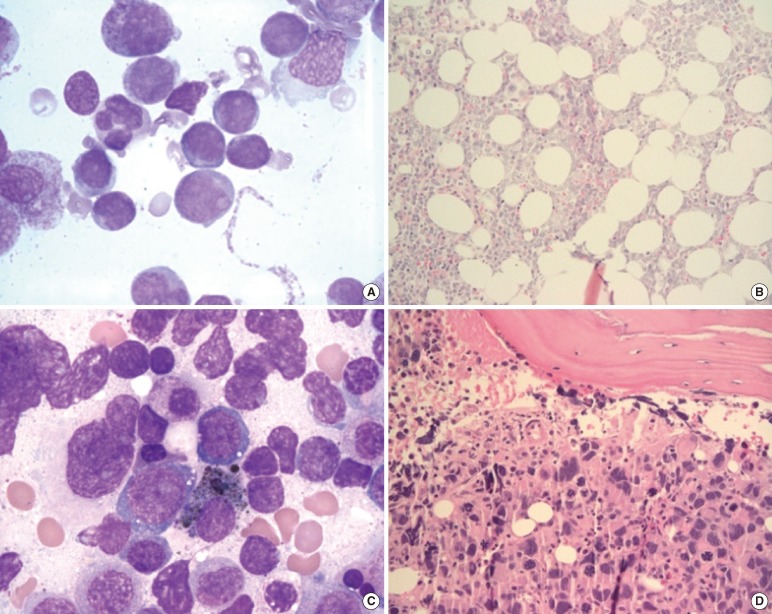
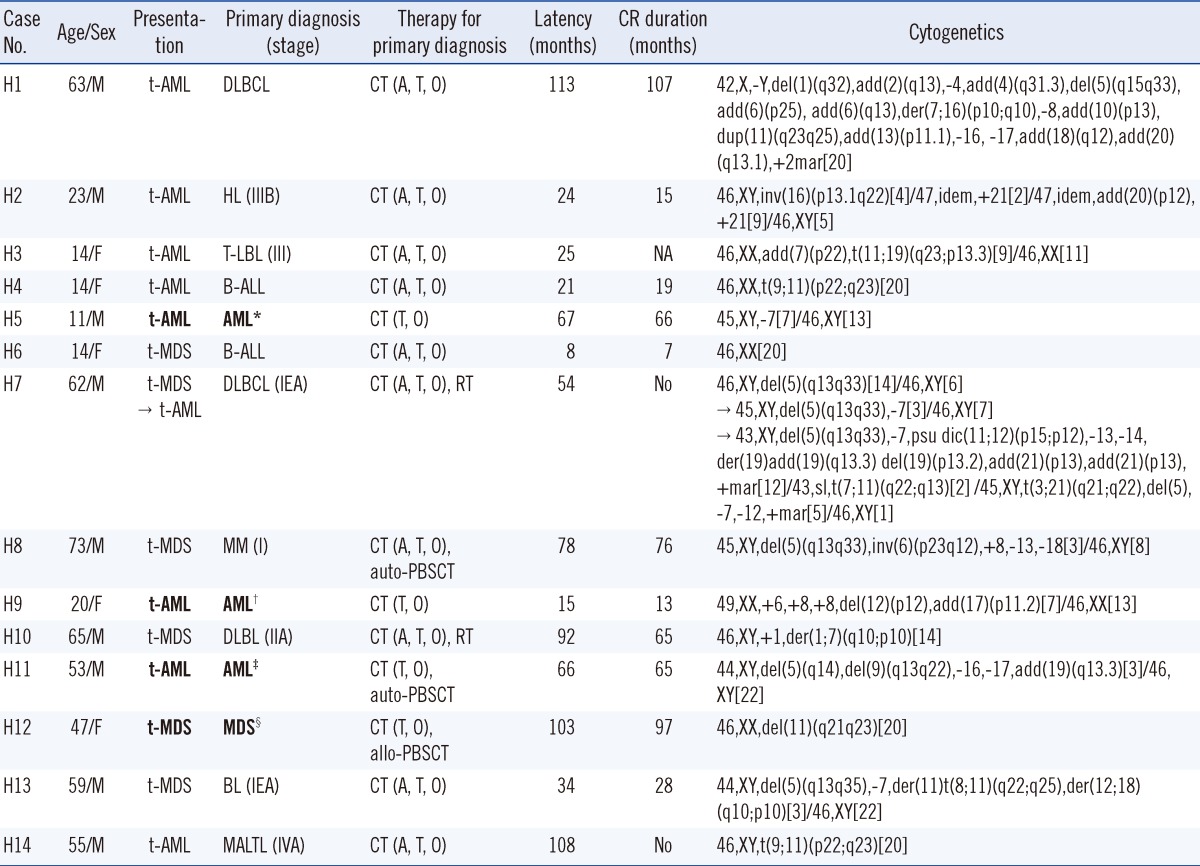
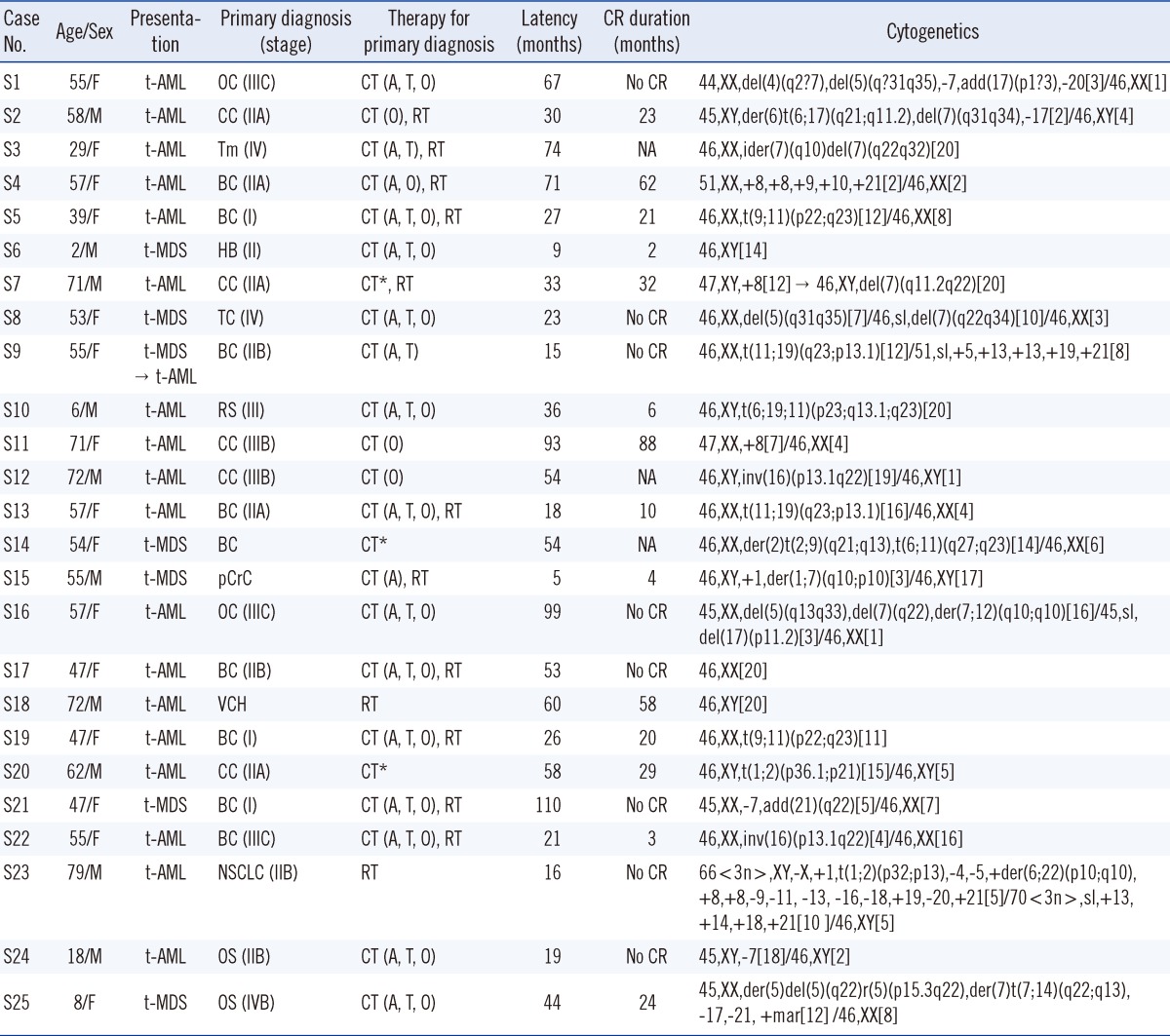




 PDF
PDF ePub
ePub Citation
Citation Print
Print


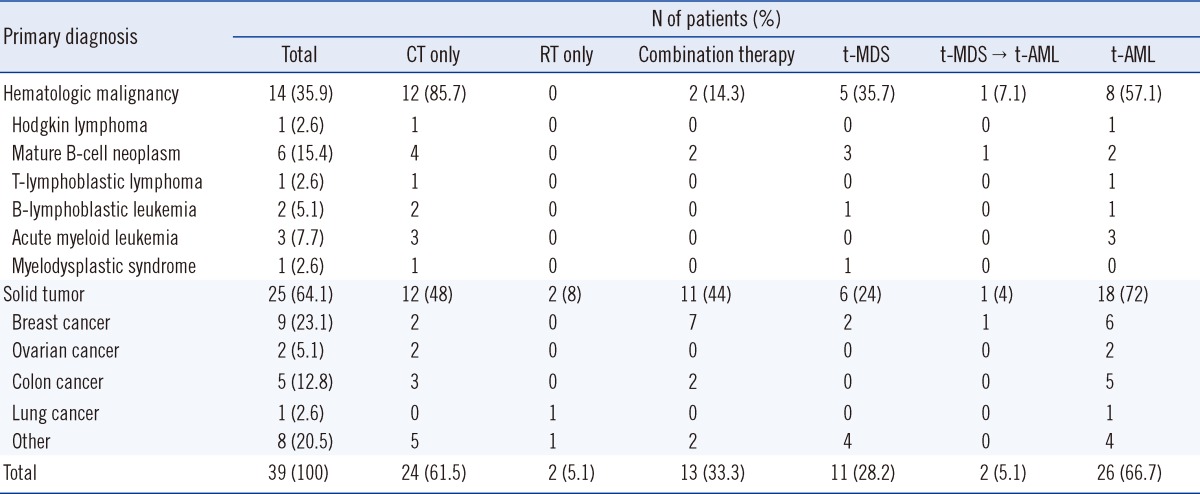
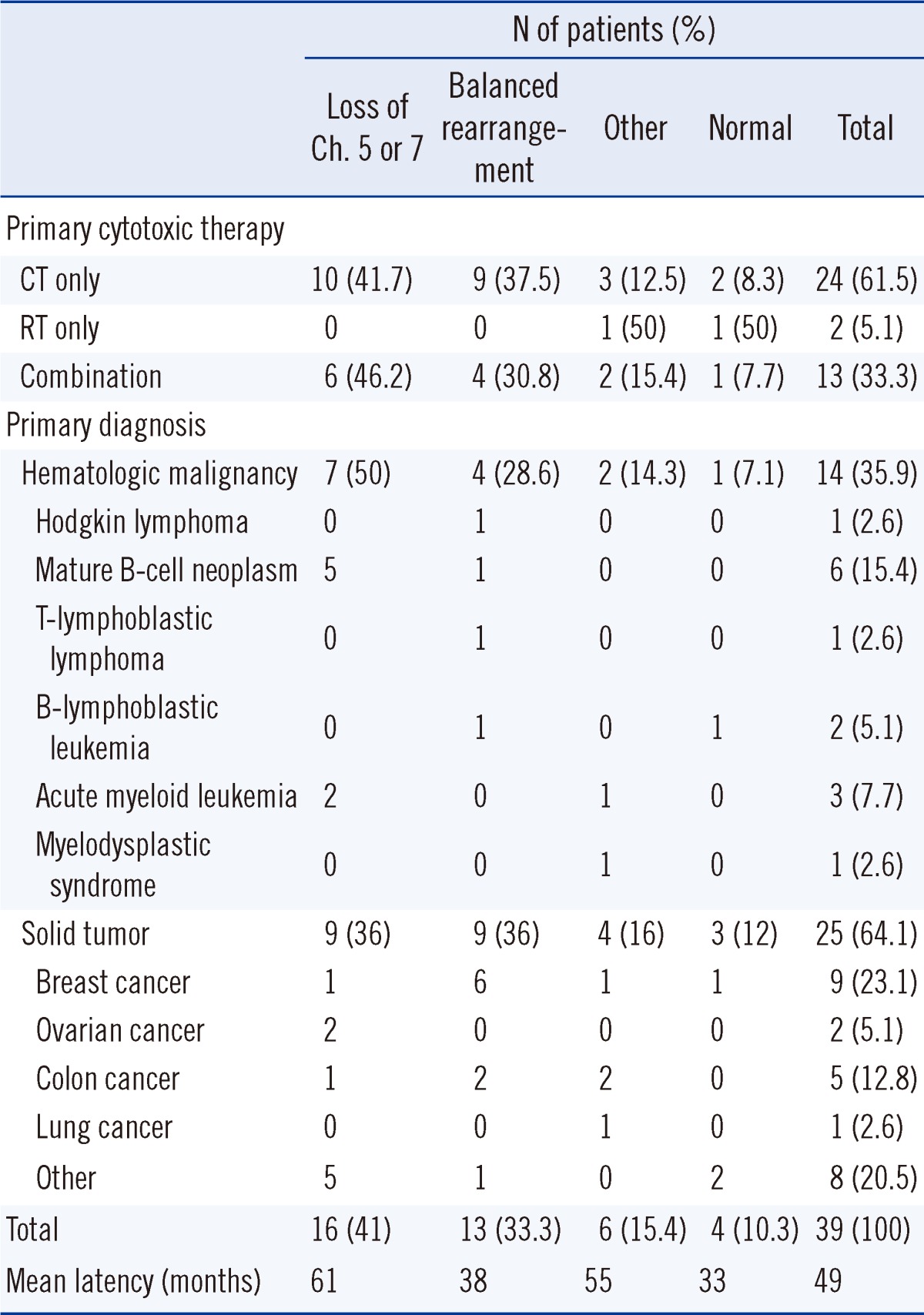
 XML Download
XML Download